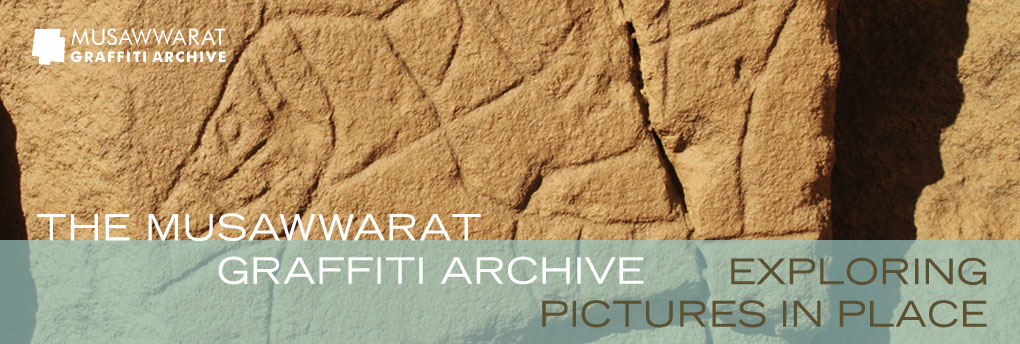Pictorial Graffiti
Pictorial graffiti, the second category defined for the Musawwarat graffiti corpus, comprise a wide range of individual and composite figurative and geometric motifs as well as motifs that have both figurative and geometric elements. Figurative graffiti include zoomorphs, anthropomorphs and hybrids, plants, objects and architectural features as well as Meroitic ‘symbols’ – and combinations thereof.
Geometric motifs are those graffiti that resemble geometric shapes, such as straight, curved, crossing and touching lines, circles, ovals, rectangles, triangles and combinations thereof. Motifs that potentially have both figurative and geometric components are so-called ‘property marks’ or magico-religious ‘signs’ that may, for example, consist of a geometric ‘base-form’ and a figurative Meroitic ‘symbol’.
Many of the pictorial graffiti appear to have been added to the walls of the Great Enclosure as individual, ‘stand-alone’ entities. In some cases motifs are composed of two or more elements that can also occur as individual motifs. Such composite motifs are, for example, an anthropomorph and a camel or an anthropomorph and a horse in the case of ‘camel rider’ or ‘horse rider’ motifs. Conversely, two or more physically separate, juxtaposed graffiti entities can form a motif, such as in ‘dog-hare’ or ‘giraffe(s)-tree’ motifs. In the latter cases, similarities in technique, line and form characteristics, proximity and/or directionality suggest that two or more graffiti entities were made at the same time and by ‘one hand’. In other cases juxtapositions seem to have been ‘built up’ over time and by different individuals.
The narrative quality inherent in the Musawwarat graffiti becomes more pronounced when several graffiti entities or elements are composed in more complex ways. This is illustrated in numerous ‘hunting’ or ‘fighting scenes’, some of which are clearly mythological. Another prominent example are the so-called ‘beer drinkers’, two individuals squatting to the sides of what appears to be a ‘beer jar’, and apparently drinking from the jar with ‘straws’.
Text: Cornelia Kleinitz (2014)







